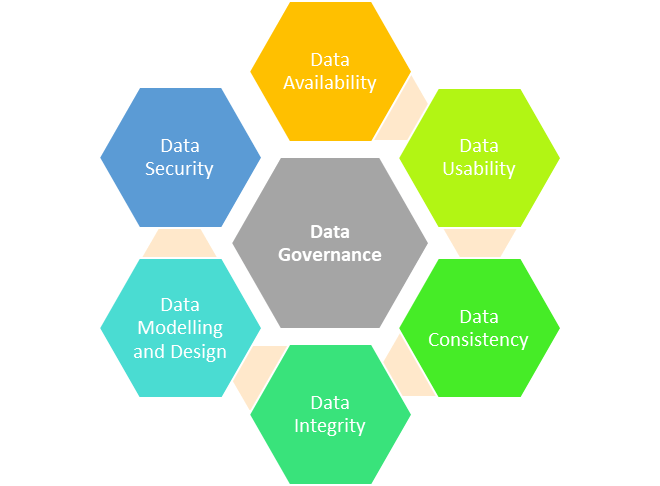Data governance in the context of data warehousing assumes greater importance. In strengthening data governance, factors like what data to be processed, how data should be made available to end users and how information from data warehouse can be leveraged to meet business goals are some of the salient features considered to maximize value from data warehousing.
What is Data Governance
Data Governance is a key ‘Data Management’ concept that ensures high ‘Data Quality’ exists throughout the life-cycle of data management process in a Data Warehouse project.
Effective Data Governance aids in strengthening the following key focus areas:
- Data Availability
- Data Usability
- Data Consistency
- Data Integrity
- Data Modelling and Design
- Data Security

Why Data Governance
Data Governance helps organizations to manage information knowledge and also find answers to some of the searching queries including:
- What do we know about our organization information?
- Where did this data come from to our organization?
- Whether the available data falls in line with our organization policies?
- Whether the data is associated to a data dictionary?
By augmenting data governance, organizations reap benefits in terms of:
- Improving data security, and also by defining and verifying the requirements for data distribution practices
- Designating accountability pertaining to information quality
- Improving data quality by enabling data consistency and accuracy as well as assuring completeness
- Minimizing or eliminating re-work
- Improving data-driven business decisions and planning
How to Strengthen Data Governance – Leveraging Data Governance Framework
Data Governance Framework affects the processes that people leverage to create as well as retain the data. It helps to replicate the following Framework steps to enable business users take decisions faster.
Policies – As a significant step in the Data Governance Framework, it is essential to focus on salient features associated with policies, including:
- Accountability
- Validation Standards
- Data Privacy Guidelines
- Data Access and Usage
- Data Retention
- Data Masking and Archiving Policies
Process – With process emerging as a critical element of Data Governance Framework, it is important to focus on the main stages of Data Governance process including discovery, definition and application (rules and policies).
Security – When it comes to security, which is a key phase of Data Governance Framework, organizational attention turns to internal and external data in terms of monitoring and revising privacy policies, as well as in ensuring role-based access to data with proper encryptions.
Data Quality – Data quality represents another key step in augmenting Data Governance Framework, wherein it is critical to use data quality techniques as well as methods to efficiently transform data influencing business processes, decisions, and interactions and ensure organized data is flexible to business.
MDM – MDM is another important phase marked for combining data from various systems and applications to create a single-source-of-truth (Example. Create customer 360-degree view).
Organization alignment – This is a key element where the focus falls on the working relationships encompassing organization roles and data ownership. The recommended assignment matrix that matters more to set expectations pertaining to all organizational aspects include RACI and DACI.
Note: RACI – responsible, accountable, consulted, and informed/DACI (driver, approver, contributors, and informed).

Common Pitfalls that weaken Data Governance
- Individuals in an organization realize the importance of data governance only after system implementation and only when they are pushed to deal with issues
- Without any proper data quality benchmark, data modelling can’t be achieved – This means data quality always depends on the context in which data is used.
- As and when there is an increase in data volume, there is inconsistency across the organization
- Lack of crisp or measurable goals while implementing Data Governance framework
- Lack of standards pertaining to hierarchical data
- Departments operating in siloes





